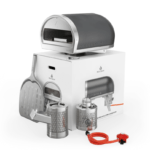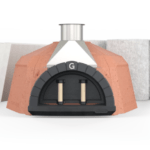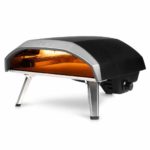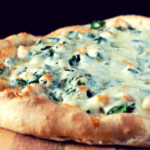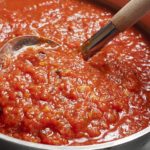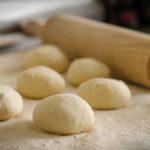What Oven Setting For Pizza Is the Best?
Are you tired of your pizza coming out too soggy or burnt? If you want to make a perfectly cooked, golden brown, and delicious homemade pizza every time, then you’ve come to the right place!
In this guide, we will explore what oven settings produce perfect pizza results every time. Let’s take a closer look.
Key Takeaways
- – Preheating your oven to 500°F is ideal for thin-crust pizza.
- – The convection bake setting and a temperature of 425°F-440°F produce perfect results for thick-crust pizzas.
- – Using the “Pizza Setting” on newer oven models is one way to customize temperature settings according to toppings.
- – Pizza stones or steels help evenly cook both thin and thick varieties while resting post-baking helps solidify cheese and allows topping liquids to settle properly before serving.
What Oven Setting For Pizza Is the Best?

When selecting the right oven setting for pizza, it’s important to consider the type of crust and whether you’re cooking a frozen or homemade variety.
Thin Crust Pizza
When it comes to cooking the perfect thin-crust pizza, having the right oven setting is key.
The baking time for thin crust pizza is generally shorter than thicker ones; 8-12 minutes should be enough for a delicious crispy yet tender result.
To best achieve this, conventional or convection bake settings are recommended over a pizza setting since these will better regulate heat and provide consistent results.
Temperature also plays an important role in creating that ideal crust texture.
Preheating your oven up to 500 degrees Fahrenheit can help crisp up a thin crust but don’t let it get too high as this can lead to burning sections of your pizza quickly!
Also, using tools like a stone or steel plate within your oven helps evenly distribute heat and prevent areas of scorching on thinner doughs.
Allowing your pizzas to rest before slicing is also essential in order to allow all ingredients to set properly while remaining moist.
Thick Crust Pizza
Thick-crust pizza requires a higher temperature and longer cooking time than thin-crust pizza due to its larger diameter.
Depending on the thickness of the dough, thick crusts will generally require baking for 10-15 minutes at around 475°F – 500°F.
For conventional ovens, setting the preset at “broil” for this type of pizza tends to result in an evenly cooked bottom but still slightly underdone top layer.
Adding five minutes onto the recommended cook time is normally sufficient to fully cook all toppings without burning or drying out your meat and veg.
On convection models, choosing anywhere from 425°F – 440°F is often enough so that you don’t overbake it.
If using additional pan modes like “Pizza Setting” may help with faster bake times while staying within these temperatures.
Make sure your particular model can handle these settings before applying them as some models may not have these options available.
Frozen Pizza
Frozen pizza is a convenient meal solution and the best way to prepare it is with the right oven setting.
Generally, for thin-crust pizzas, you should use conventional bake (at 425°F) which is best for cooking at high temperatures.
For thicker crust pizzas and frozen pizza pies, opt for “convection bake,” which circulates air around the food and cooks evenly from all angles.
Be sure to adjust your temperature according to how crispy or chewy you’d like your pizza to be – between 375°F-400°F should do the trick.
Additionally, some newer models offer a dedicated “Pizza Setting” that allows users to customize their temperature depending on toppings or pre-fry items in its cycle as well.
For perfect slices every time, make sure you properly preheat your oven before adding your frozen pizza, and double-check if the packaging has been appropriately removed prior to baking (to avoid tasting any plastic).
If using extra cheese or additional toppings, add them after 15 minutes while also adjusting the total cooking time accordingly — usually, 20–25 minutes is plenty of time but will depend on the size of the pie.
Understanding Oven Settings For Pizza
Oven settings for pizza vary depending on the type of crust, but it is important to understand what conventional bake, convection bake, and the pizza setting are in order to get perfect results every time.
Conventional Bake
The conventional bake setting is a common mode in most regular kitchen ovens. This simple, straightforward function can be used to cook pizza and other foods, though it may require a few adjustments for optimal results.
Unlike convection baking which uses fans to circulate hot air around the food and promote even cooking, this method simply utilizes preheated air without any additional movement.
It can reach quite high temperatures of up to 500 Fahrenheit or higher depending on your particular oven’s capabilities.
When using this setting you’ll want to keep an eye on your pizza as it bakes since there won’t be the same level of heat distribution as with convection settings.
So, move the pizza closer or further away from the heating element for more precise doneness if necessary.
Thin crust pizzas such as Neapolitan and New York styles generally work best with conventional bake due to their short baking time; thicker pizzas can easily burn before being done when set too close to the element.
Frozen pizzas also respond better when cooked in a conventional setting rather than trying too aggressively brown them in convection.
Convection Bake
Convection bake is a setting designed to deliver consistent heating and penetration across your pizza.
Unlike regular baking, where heat is targeted on one part of the pizza, convection ovens feature fans that help spread the heat evenly throughout.
Convection ovens are especially great for baking multiple pizzas at once since the consistent temperature ensures each pizza gets an equal amount of time in the oven.
Different types of convection settings such as convect roast or convect bake may be beneficial when trying to achieve different levels of doneness for different kinds of pizzas.
Adjusting both time and temperature according to thickness and type accordingly can guarantee desired results every time.
And as always, remember to preheat your oven before you begin cooking.
Pizza Setting
Modern ovens feature a unique setting dedicated to baking the perfect pizza.
This is known as the pizza setting which typically maintains a temperature of anywhere between 200 and 250 degrees Celsius or 400 to 500 degrees Fahrenheit.
Unlike other oven settings, the pizza setting is specifically designed to replicate traditional brick-oven cooking techniques with consistent airflow and heat levels that reach deep into different types of pizza dough– whether it be thin-crust or thick-crust varieties.
The consistent airflow ensures the crust cooks evenly while producing thorough cooking on top.
Conclusion
In summary, it’s important to preheat the oven for at least 30 minutes before putting in the pizza and to find out what temperature works best for whichever type of crust you are using.
If you don’t have a pizza stone or steel, use heavy-duty foil instead to prevent sticking. You can also experiment with different cooking techniques such as reducing time or raising temperatures until you get consistent results every time.

